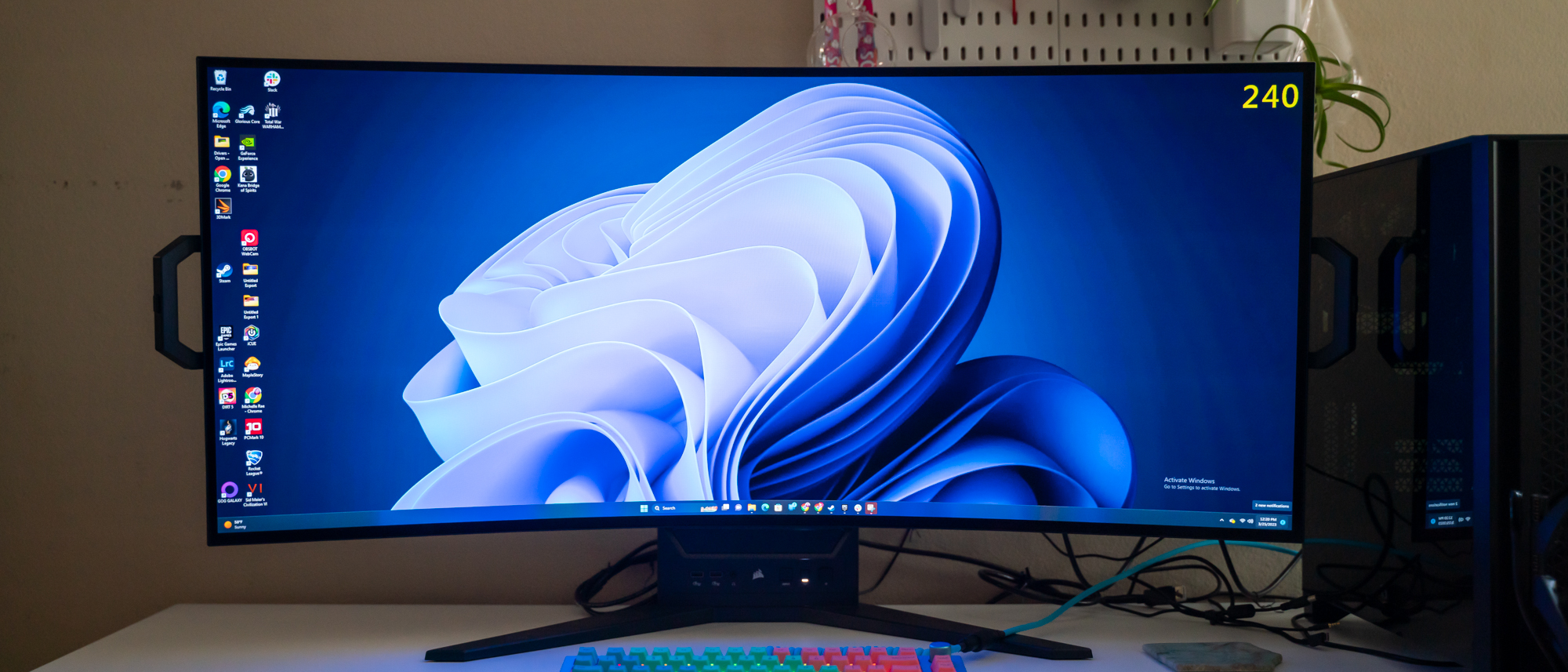TechRadar Verdict
The Corsair Xeneon Flex 45WQHD240 OLED is by no means perfect. The bending mechanism still feels clunky, and for an expensive piece of kit, there are things you can’t do here – limitations largely caused by its bendable nature. HDR10 support is also disappointing. However, if a truly versatile and immersive gaming monitor with gorgeous picture quality and rich colors is what you’re seeking, this is worth it. That is, you can afford it.
Pros
- +
Excellent picture quality
- +
Allows you to shift genres without sacrificing immersion
- +
Rich colors with deep blacks
- +
Fast response
Cons
- -
No swivel or height adjustments
- -
Bending mechanism still feels clunky
- -
Expensive piece of kit
- -
HDR on decreases contrast and color vibrancy
Why you can trust TechRadar
Corsair Xeneon Flex: Two-minute review
It was only a matter of time before bendable displays such as the Corsair Xeneon Flex 45WQHD240 OLED hit the gaming industry. I just didn’t think they’d come so soon. We just got our first round of OLED gaming displays last year, after all. And, more 500Hz monitors might roll out soon, following the release of the Alienware AW720H, which I’m still not sure is something that can serve the general gaming population at this moment.
There’s also the fact that we’ve just come out of the pandemic and are now in the middle of inflation, which mean two things: we’re no longer spending as much quality time in front of our gaming PCs as most of us are back on the grind, and many just cannot afford such luxuries right now.
But while a part of me struggles to recommend a gaming monitor that’s clearly out of most people’s budget – my 55-inch Samsung TV, which I got on sale, cost me less than half its price tag, for god’s sake – an even bigger part of me screams, “What took them (manufacturers) so long?!”

The Corsair Xeneon Flex 45WQHD240 OLED’s main appeal is that you’re getting both a curved monitor and a flat one, as well as an ultrawide display, making it incredibly versatile for a wide range of uses and one of the best monitors I’ve ever tested.
I don’t spend a lot of time gaming myself because who has the time these days, but even I can see the potential here. The fact that it’s capable of displaying different game genres the way they’re supposed to be experienced – whether flat, at 1200R curvature, or at that deep 800R curvature – is already impressive to me.
Corsair pushes hard on the premise that different genres were never meant to be experienced on the same type of display, which is largely true. And with the Xeneon Flex, gamers are getting that all-in-one experience, which should benefit those of you who aren't very selective when it comes to the types of games you play.
In addition, because it is incredibly color accurate, with a Delta E of less than 1 (the lower, the better), and because of its color coverage, one can argue (read: help justify the price) that it’s also excellent for creative tasks, including video and photo editing. Heck, this has been my main monitor for work for well over a week, and just its 21:9 aspect ratio and 45-inch screen real estate alone has improved my productivity. Now my dream is for bendable monitors to become the norm so that we can all afford one without making our wallets bleed.
Sign up for breaking news, reviews, opinion, top tech deals, and more.

Clunky yet still elegant
Understandably, the Corsair Xeneon Flex 45WQHD240 OLED still has some clunkiness to it. Someday hopefully soon, we’ll look back at this time and marvel at the quaint way we used to bend and fold our displays while we’re pressing that special button on our monitors that gets them to the curvature we want. You know, much like you would adjust the height of a standing desk now.
But at this present time, there’s still physical work involved and a lot of creaking and clunking too. At least where this offering from Corsair is concerned (I will be testing the LG OLED Flex (LX3) soon so I’ll soon find out how LG’s bending process is). That isn’t to say that the display itself isn’t elegant because it is; it’s just the bending mechanism that needs some finessing.

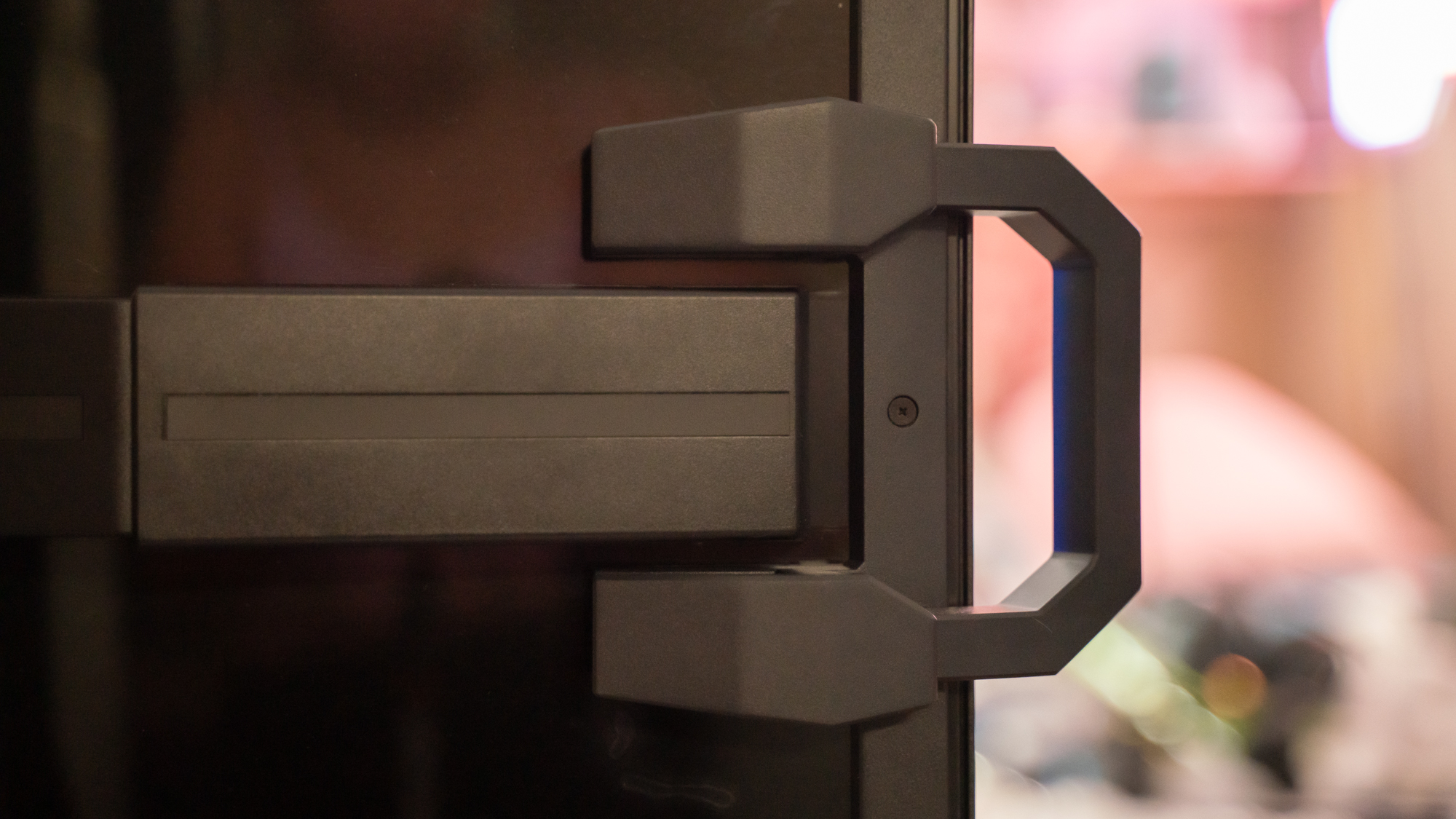

The way it works is that there are two thick bars in the back that run about half the length of the display on both sides, and they’re responsible for guiding and supporting the panel itself during the bending process. So, when you’re adjusting the curvature of the panel, it’s really these bars that you’re controlling via the two handles that jut out of them on either side of the display. And that requires some upper body force from you – not a lot that you feel like you’ve just bench pressed at the gym, but enough to make you nervous in your earliest attempt as it feels like you might break the very thin (more specifically, a quarter of an inch thick) panel.
Luckily, the whole thing feels very robust so there seems to be no danger of damaging anything here when you’re bending or unbending. The stand and mount also feel very solid and stable, managing to weigh the display down and keep it steady during the process as well as when you’re adjusting tilt – though that also means that it is on the heavier side.


Sadly, though, there aren’t any swivel or height adjustments here, which I”m guessing has a lot to do with the bending mechanism. Being able to adjust the height honestly would have been nice, especially because Corsair has placed the display’s USB hub and OSD and power buttons on the front of the stand just beneath the panel, just behind the bottom tilt handle. They’re a little harder to access especially if you’ve got a PC soundbar in your setup as I do. Although, don’t get me wrong; having a hub front and center is a nice and much-appreciated touch.

On the opposite side of the stand are the rest of the ports, which I also appreciate as I don’t have to go through hoops to access them. And, there’s a decent helping of input ports too – two HDMI 2.1 for those with current-gen consoles, a DisplayPort 1.4, and a USB Type-C with DP Alt-Mode for your laptop.
Gorgeous at any curvature
Corsair has historically done an impressive job with its gaming displays, and the Corsair Xeneon Flex 45WQHD240 OLED doesn’t fall far from the tree. Clearly, the 3440x1440 is much more than enough to deliver excellent picture quality, even if its pixel density of 83 PPI may displease some gamers (95 to 110 PPI is usually ideal for gaming).
The games I played on this were still sharp and detailed to be immersive, and honestly, that’s more than good enough for most gamers. The fast refresh rate of up to 240Hz and 0.03ms GtG response time also helped faster games like Cyberpunk 2077 and Rocket League have reduced ghosting and motion blur – also resulting in better clarity and picture quality.
Just bear in mind that you do need powerful hardware to run more demanding games at 240Hz. For example, I tested this monitor with my RTX 3060 Corsair PC Build Kit, and while the Cyberpunk 2077 consistently ran at 240Hz, the PC struggled to hit that mark with the newer Hogwarts Legacy. But, thanks to the display’s adaptive sync, I didn’t experience any screen tearing.
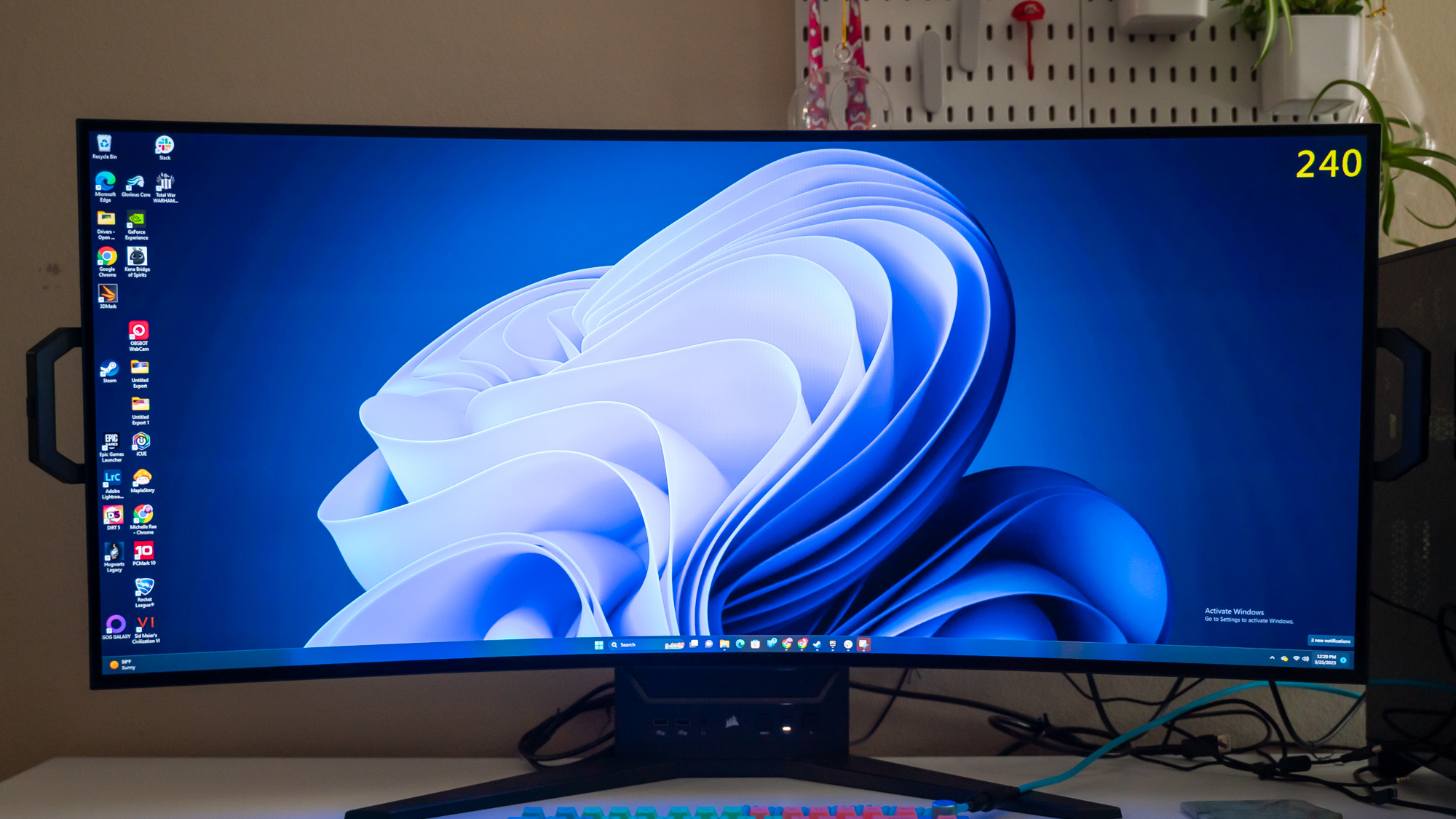
The colors are gorgeous as well. My colorimeter reading gave me just under 100% DCI-P3 and 100% sRGB as promised. Combine that with the fact that it’s more accurate than most monitors on the market, beating the common DeltaE<2 accuracy by averaging at less than 1, it’s good enough for content creation as well, which you should do on this display’s flat layout. For productivity, I liked it best at a shallower curve of 1200R.
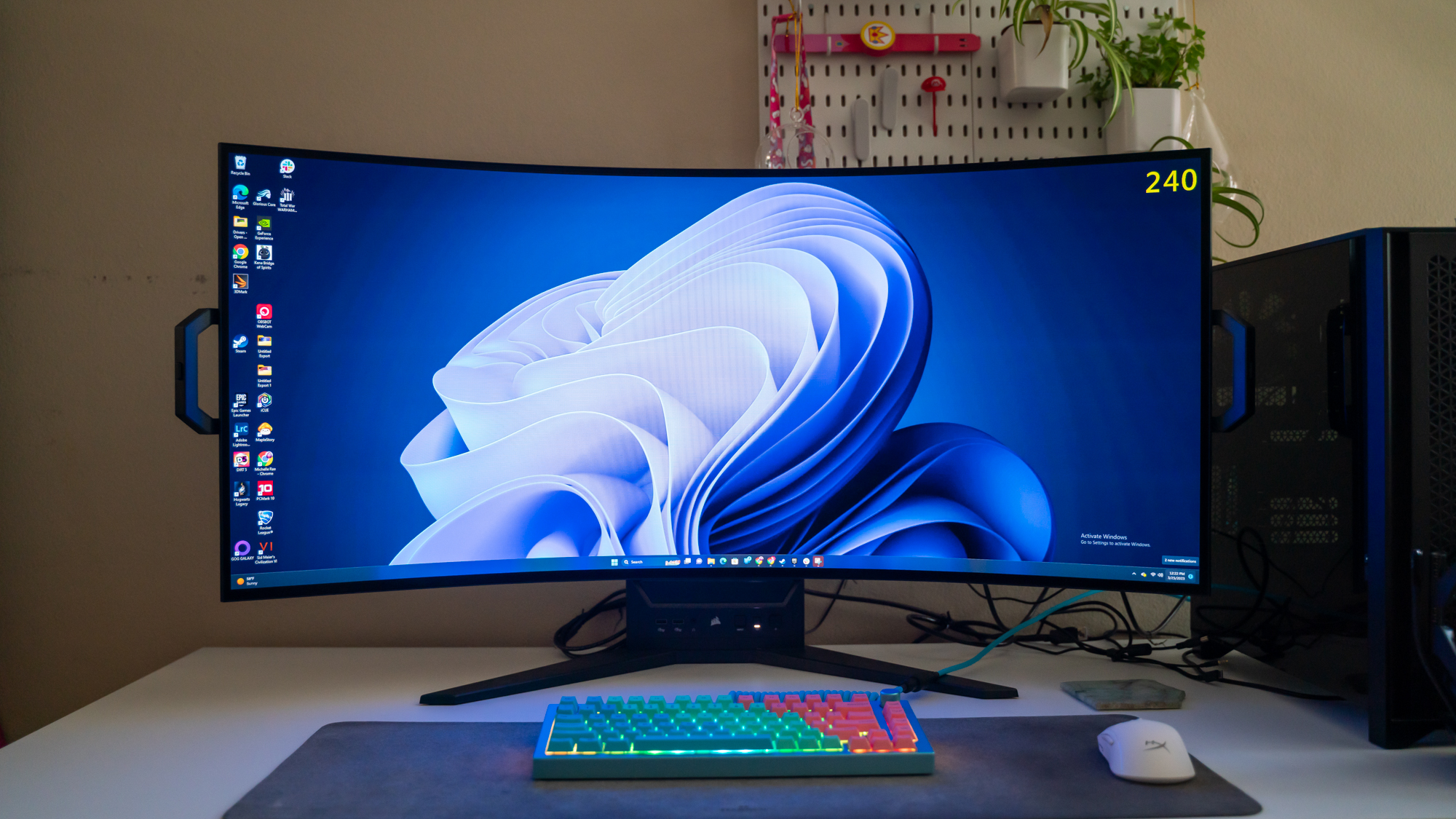
It’s in gaming that its ability to bend at different curvatures really comes into play. I found playing games like Rocket League and Sid Meier's Civilization VI to be disorienting at 800R or even 1000R curvature, with the field lines on the former weirdly arched and the map on the latter looking like it’s inside a fish bowl, but looking their best as soon as I switched back to the flat layout.
Meanwhile, Cyberpunk 2077 and Hogwarts Legacy felt much more immersive at 800R curvature, as if I were inside the actual games instead of viewing them on a gaming display. Better yet, I also didn’t have to overextend my eyes or crane my neck since everything felt like it was within my field of vision.
Sadly, the HDR here isn’t anything to write home about – well, unless you want to complain about it. Despite the 1000-nit peak brightness, you’re only getting HDR10 and not a VESA-certified HDR1000. So, although the display manages to brighten the screen when in HDR mode, the resulting picture quality looks washed out and overexposed. The contrast is drastically reduced, as is the color vibrancy. I would skip turning the HDR on, if I were you.
Corsair Xeneon Flex: Price & availability
- How much does it cost? $1,999.99 / £2,099.99 / AU$3,299.99
- When is it available? Available now
- Where can you get it? Available in the US, UK, and Australia
The Corsair Xeneon Flex 45WQHD240 OLED is a massive investment at $1,999.99 / £2,099.99 / AU$3,299.99, so while that shouldn't stop budget-minded consumers from saving up to get it, I recommend really thinking it through before hitting that buy button.
To be fair, many ultrawide monitors sit within the $1,000/£1,000 to $2,000/£2,000. The LG UltraGear 38GN950 cost £1,499 (around $2,000 / AU$2,700) when it first came out while the Samsung Odyssey Neo G9 cost $2,499 / £1,749 / AU$2,999. Considering that the Xeneon Flex throws in that new flexible display technology, I think it's only reasonable it costs this much.
Note that LG's bendable monitor entry, the 42-inch 16:9 LG OLED Flex (LX3) 4K monitor, is even pricier at $2,999 (about £2,450 / AU$4,500).
- Value: 3 / 5
Corsair Xeneon Flex: Specs
| Screen size: | 45-inch |
| Aspect ratio: | 21:9 |
| Resolution: | 3440x1440 |
| Brightness: | 1,000nit peak brightness |
| Refresh rate: | 240Hz |
| Response time: | GtG 0.03ms |
| Viewing angle: | 178 / 178 |
| Contrast ratio: | 1,500,000:1 |
| Color support: | 1.07B (10-bit RGB)100% sRGB, 98.5% DCI-P3, 96.3% AdobeRGB |
| Inputs: | 2x HDMI 2.1, 1x DisplayPort 1.4, 1x USB Type-C DP Alt-Mode |
| Weight: | 13.9 pounds (6.3kg) |
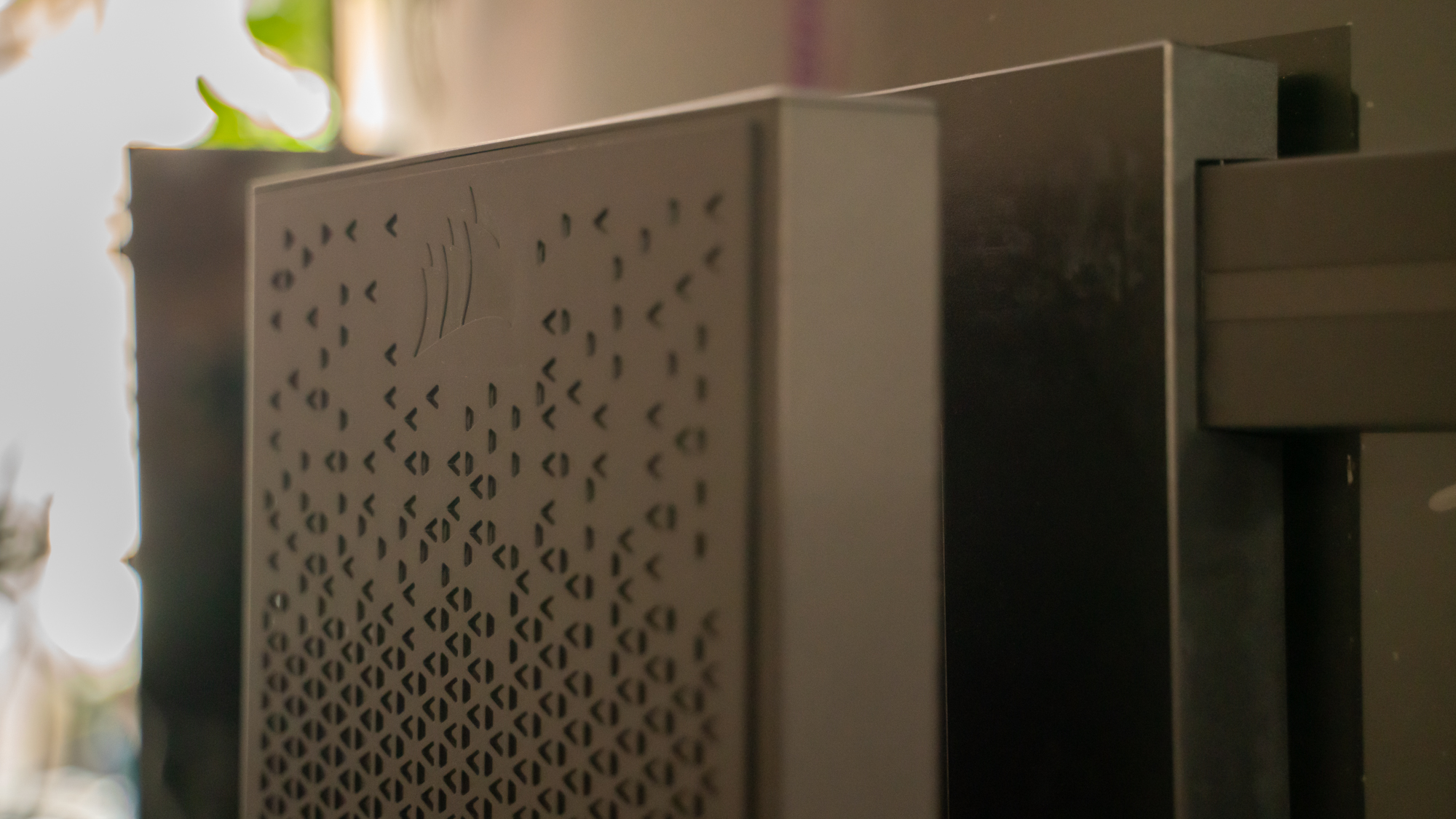
Should you buy the Corsair Xeneon Flex?
| Value | It's expensive, but the price is reasonable considering the new technology and its ultrawide monitor form factor. | 3 / 5 |
| Design | The bending mechanism is a bit clunky, but it's not difficult to operate. The overall design is great as well. | 4.5 / 5 |
| Performance | Its gorgeous picture quality, fast refresh rate, and accurate colors make it an excellent display for gaming, content creation, and productivity. | 4.5 / 5 |
| Average rating | The Corsair Xeneon Flex is an impressive piece of kit, even if it needs a bit of finessing. | 4 / 5 |
Buy it if...
You want to be an early adopter
...of the bendable gaming monitor tech. It's very expensive, as with all new technology, but it's a terrific display in its own right.
You want a versatile gaming monitor
Whatever game you're playing, it'll look great on this monitor, thanks to its versatile bendable design that give you up to 800R curvature.
Don't buy it if...
You're broke like the rest of the world
We're still in the middle of a cost of living crisis, so this might not be the right time to purchase this.
You want a 4K display
This is a 3440x1440 display with just an 83PPI pixel density. If you want a higher resolution display, there are other options.
Corsair Xeneon Flex: Also consider
| Corsair Xeneon Flex | LG OLED Flex (LX3) | |
|---|---|---|
| Price: | $1,999.99 / £2,099.99 / AU$3,299.99 | $2,999 (about £2,450 / AU$4,500) |
| Screen size: | 45-inch | 42-inch |
| Aspect ratio: | 21:9 | 16:9 |
| Resolution: | 3440x1440 | 3,840 x 2,160 |
| Brightness: | 1,000nit peak brightness | Not listed |
| Refresh rate: | 240Hz | 120Hz |
| Response time: | GtG 0.03ms | 0.1ms |
| Viewing angle: | 178 / 178 | 178 / 178 |
| Contrast ratio: | 1,500,000:1 | Not listed |
| Color support: | 1.07B 10-bit RGB, 100% (sRGB), 98.5% DCI-P3, 96.3% AdobeRGB | Not listed |
| Inputs: | 2x HDMI 2.1, 1x DisplayPort 1.4, 1x USB Type-C DP Alt-Mode | 4 x HDMI 2.1 |
| Weight: | 7.7lb (3.5 Kg) | Not listed |
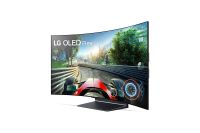
LG OLED Flex (LX3)
Though we have yet to review this 4K monitor, it's another bendable display for gaming, if you're looking to invest in the tech.
How I tested the Corsair Xeneon Flex
- I tested the monitor for a little over a week
- I used it for gaming, photo editing, media consumption and productivity work
- I used a colorimeter as well as different types of games and photo editing software
Given that this is a gaming monitor, I primarily used it for gaming. But I also used it as my main monitor for work and photo editing for a little over a week. Naturally, I tested its bending mechanism as well.
I used four different games from different genres to test this display, comparing how each one looks in both flat and curve layouts. I also used Adobe Photoshop and Lightroom for photo editing, and several streaming services as well as utilized a colorimeter to determine its color accuracy and color gamut.
I've been testing productivity, creator, and gaming monitors for years, having reviewed them for different publications including some of TechRadar's sister site. I've also done multiple monitor reviews for TechRadar.
We pride ourselves on our independence and our rigorous review-testing process, offering up long-term attention to the products we review and making sure our reviews are updated and maintained - regardless of when a device was released, if you can still buy it, it's on our radar.
First reviewed March 2023

Michelle Rae Uy is the former Computing Reviews and Buying Guides Editor at TechRadar. She's a Los Angeles-based tech, travel and lifestyle writer covering a wide range of topics, from computing to the latest in green commutes to the best hiking trails. She's an ambivert who enjoys communing with nature and traveling for months at a time just as much as watching movies and playing sim games at home. That also means that she has a lot more avenues to explore in terms of understanding how tech can improve the different aspects of our lives.
